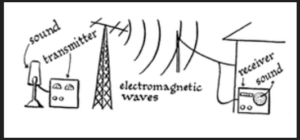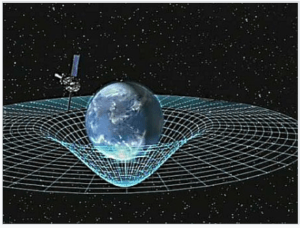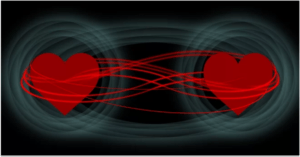In everyday life, we assume the principle of locality. Here’s the principle of locality: Causing an effect on an object or energy


Since the acceptance of Einstein’s Theory of Special Relativity in the early 1900’s, the principle of locality has included the proviso that a cause cannot occur faster than the speed of light. Electromagnetic waves travel through the vacuum of space at the speed of light. This is about 186,000 miles per second. In other media, electromagnetic waves can travel slower than the speed of light but never faster. Never, for example, instantaneously.
Nor, according to Special Relativity, can any matter or energy travel faster than the speed of light. The implication for the principle of locality is that no cause can cross a distance faster than the speed of light and create an effect on something else. The fairy cannot wave her magic wand and, instantaneously, the pumpkin turns into a coach. According to the principle of locality, whatever unknown force might be exerted by the fairy, it requires time to cover the distance to the pumpkin, at least the time that it takes light to travel.
Sometimes, people express the principle of locality by saying that it means that no energy or matter can cross a distance to another energy or matter and affect it at a speed faster than the speed of light. This is sometimes also called “relativistic locality.”
Action-at-a-Distance, as in Gravity, Discarded

But Newton’s mathematical laws seemed to support this absurd idea. And the theory is close enough to empirical experience that it has very practical uses in engineering. So, the mass-attracts-mass theory stuck. It is this Newtonian understanding of gravity that is relied on for most modern engineering projects, including the moon shots of the 20th Century.
However, many decades ago, among physicists, Einstein’s Theory of General Relativity replaced Newton’s action-at-a-distance explanation of gravity. General Relativity was accepted by theoretical physicists soon after Einstein proposed it in 1915. This is not due to Einstein’s reputation but because his theory predicts empirical results more accurately than does Newton’s action-at-a-distance. The divergence between the predictions of the two theories becomes significant when large masses are involved. For example, the equations of General Relativity describe the orbit of Mercury around the sun accurately, whereas Newton’s gravitational equations do not.
So, even in the case of gravity, objects do not exert an instantaneous force on each other through empty space. There must be touching—that is, interaction. In the case of General Relativity, objects with mass touch spacetime itself. It is spacetime, specifically its curvature, that creates the effects that we call “gravity.” Objects fall because they are touching and interacting with curved spacetime. This might be a puzzling statement if one imagines spacetime to be a nothingness. But Einstein doesn’t imagine spacetime this way. He imagines it as a substance. He variously called it a “field” or an “ether.”
For example, in 1920, Einstein wrote:
“According to the general theory of relativity space without ether is unthinkable; for in such space there not only would be no propagation of light, but also no possibility of existence for standards of space and time (measuring-rods and clocks), nor therefore any space-time intervals in the physical sense.”
At other times, Einstein rejected the term “ether,” but Einstein’s bottom line was that spacetime is not nothing. It is something, and that something interacts with matter and energy.
In quantum mechanics, locality is problematic.
Describing quantum mechanics is complicated by there being so many interpretations of it. The description which follows sees quantum mechanics through the eyes of the Transactional Interpretation.
While macroscopic objects like tables and chairs are subject to the principle of locality, many physicists have severe doubts as to whether the principle of locality applies in the quantum world. The equations which describe quantum entanglement seem to tell us that two particles across the universe from each other can correlate their behavior simultaneously. Simultaneous is faster than the speed of light. And lab experiments which demonstrate quantum entanglement seem to support these equations. Quantum mechanics seems to demonstrate nonlocality.


-
- The Many Worlds Interpretation proposes that if we abandon our usual understanding of reality, the principle of locality can be preserved. The Many Worlds Interpretation proposes that every time a quantum particle adopts one property from among alternatives, more universes are created. In each alternative universe, the particle chooses a different alternative. For example, let’s say that upon detection, you, as the experimenter find that the particle has landed at Position A on the detection screen. Then, in other universes the particle would have landed in each possible other position. And in each universe, another version of you, the experimenter, will have witnessed the results.
Thus, an endless number of universes are created with each change of properties of each particle. In this type of reality (for reasons that I don’t know), physicists argue that the phenomenon of quantum entanglement does not violate the principle of locality.
-
- Superdeterminism proposes that since the Big Bang, every action has been determined, including the decisions and actions of the physicists measuring entangled particles. In this situation, entanglement could be no more than an apparency. Really, some completely different principle might be involved: some unknown force might be pulling the strings. This force could cause the physicist to choose to measure the particle in a certain way at a certain moment and could cause both particles to have correlated properties. Thus, superdeterminism involves an absence of Free Will on the part of the experimenter.
One force of this type would be God. In this view, God would be pulling the strings of everything in the universe, causing the experimenter to choose to do specific measurements and causing correlations of entangled particles such that it appears that they’re affecting each other at speeds faster than light.
Superdeterminism would undermine the possibility of finding anything out using scientific methods. We’d only be finding out what God would want us to find out. He could easily be hoodwinking us. As science has been extremely successful in allowing us to control the material world, Superdeterminism does not seem like a fruitful path.
Further, Superdeterminism appears to have been eliminated as a possibility by a 2015 experiment conducted at the Colorado National Institute of Standards and Technology in coordination with the Jet Propulsion Laboratory in Pasadena, California. Later experiments have confirmed the results of the 2015 experiment. These results were written up in an article titled “NIST Team Proves Spooky Action at a Distance Is Real.“
Bohmian Interpretation of Quantum Mechanics—Locality Addressed
The Bohmian Interpretation of quantum mechanics explicitly accepts that quantum mechanics is non-local. This is a key reason that many physicists can’t swallow this interpretation.
The Bohmian Interpretation holds that all particles in the universe are entangled with each other. The behavior of one particle influences all other particles in the universe instantaneously, regardless of distance. All particles in the universe share a single equation, a single wave function, which is sometimes called the “universal wave function.” The entire universe evolves together in accordance with this giant equation. According to this view, a person waving a magnet around on Earth has an instantaneous effect, however negligible, on the electrons on Pluto.
Here is the Stanford Encyclopedia of Philosophy description of Bohmian nonlocality. (It calls the Bohmian Interpretation an alternative name, “Bohmian Mechanics.”) The quote also refers to the famous work of physicist, John Bell, who drew inspiration from Bohm’s interpretation.
“Bohmian mechanics makes explicit the most dramatic feature of quantum theory: quantum nonlocality….
“It should be emphasized that the nonlocality of Bohmian mechanics derives solely from the nonlocality… built into the structure of standard quantum theory. This nonlocality originates from a wave function on configuration space, an abstraction which, roughly speaking, combines—or binds—distant particles into a single irreducible reality. As Bell has stressed, ‘That the guiding wave, in the general case, propagates not in ordinary three-space but in a multidimensional-configuration space is the origin of the notorious ‘nonlocality’ of quantum mechanics. It is a merit of the de Broglie-Bohm version to bring this out so explicitly that it cannot be ignored.’ “
In other words, quantum nonlocality appears in the mathematical equations of the Copenhagen Interpretation (“standard quantum theory”) and has been demonstrated repeatedly in the laboratory. As the Stanford encyclopedia says, “[I]t’s built into the structure of standard quantum theory.” But, the Copenhagen Interpretation provides no explanation for nonlocality and the apparent violation of universe’s speed limit: the speed of light. The Copenhagen Interpretation simply does not address the issue.
Due to its explicit nonlocality, the Bohmian Interpretation is able to provide a mechanism for entanglement. It posits that two entangled particles act in a coordinated manner, regardless of distance, because they are part of the same thing. Everything in the universe is part of the same thing.
This fits the mystics’ view that “we are all one.” But it doesn’t fit the view of many physicists. David Bohm was very engaged by the idea of wholism, a concept important in Buddhism as well as other Eastern religions. It’s also important in New Age philosophies. His book Wholeness and the Implicate Order, as well as some of his other writings, explore the implications of quantum physics for issues of locality and wholism.
Summary of Quantum Mechanics and Locality
Given experimental results demonstrating quantum entanglement, it’s not possible that our universe is characterized by all three at the quantum level: locality, realism, and the freedom of the experimenter to choose which experiment to conduct (freedom from “Superdeterminism”). One of these assumptions must be inapplicable in quantum mechanics. Yet all three assumptions underlie classical physics, including Special Relativity.
When, in the 1930’s, the possible violation of locality became apparent in the mathematics of quantum mechanics, Albert Einstein concluded that quantum mechanics must be incomplete. As he saw it, a principle that would reconcile quantum mechanics with Special Relativity was missing. In 1935, he, along with two colleagues, published the famous EPR paper, outlining the “paradox” of the nonlocality of quantum mechanics. This paper is among the most cited physics articles of all time.
At this writing (2019), physicists generally accept the experimental results of quantum entanglement. However, physicists have not reached a consensus as to the meaning of these results for the nature of reality.
Whereas the interpretation usually taught in universities, the Copenhagen Interpretation, does not address the implications of quantum entanglement for the nature of reality, other interpretations do. The Many Worlds Interpretation, as noted above, is thought by some to preserve locality. The Bohmian Interpretation explicitly accepts nonlocality and explains it as indicative of the principle that everything in the universe is connected in a single whole.
